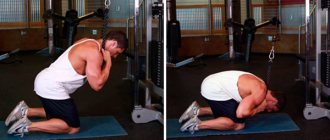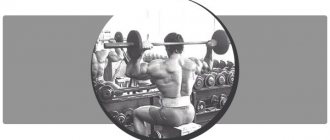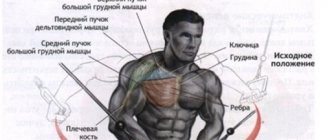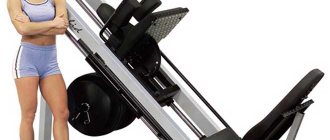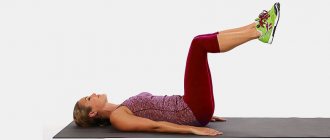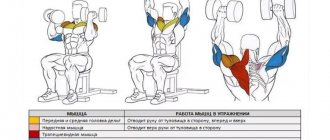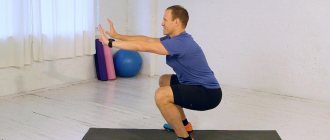Share:
What you need
- Barbell
- Bench
The bench press is a basic strength exercise that involves lowering the barbell onto your chest and lifting it while lying down on a horizontal bench. The bench press is probably the most common exercise in the world; you are unlikely to find at least one gym where almost every athlete does not perform this exercise. This exercise is one of those exercises where you can handle heavier weights due to the anatomical convenience of the flat bench press, and is a great opportunity to unlock your genetic strength potential.
When I talk about big weights, I mean really impressive numbers that can shock any beginner. The current world record in the bare bench press belongs to Russian Kirill Sarychev and is equal to a mind-blowing 335 kg. Kirill set this record in Moscow in November 2020, and who knows what result the athlete will attempt at the next competition. The Russian hero is only 27 years old, and I am sure that new records will not be long in coming, as long as there are no injuries.
In our article today we will look at:
- Why do bench press?
- How to do bench press with a barbell correctly;
- Typical mistakes;
- What are the alternatives to the classic bench press?
- How to Increase Bench Press;
- Bench press standards;
- CrossFit complexes containing bench press.
Why do you need to bench press with a barbell?
The bench press is a universal exercise suitable for developing the overall strength of the athlete and gaining muscle mass in the pectoral muscles and throughout the shoulder girdle. At the same time, the style of performing bench presses “for strength” and “for mass” is in most cases different.
When performing strength presses, we work in a small range of repetitions (usually no more than six), doing each repetition at full amplitude, fixing the barbell at the lower and upper points. In order to reduce the amplitude, as well as involve more muscles in the work, the athlete does a kind of “bridge” exercise while lying on a bench. In this case, the grip is used as wide as possible (the maximum allowed according to the rules of powerlifting is 81 cm).
When working on mass, an excellent option for performing the bench press is to work in a shortened amplitude. We do not fully extend our elbows, we work without pauses, so the pectoral muscles and triceps experience constant tension. In this case, the athlete does not bend over on the bench to shorten the amplitude, but lies flat on the bench; some experienced athletes even prefer to put their feet on the edge of the bench or keep them in the air slightly above the level of the body. The meaning is clear - this way we have fewer points of contact and do not involve antagonist muscles in the work.
The main muscle groups worked when performing the bench press are: pectorals, triceps and anterior deltoids.
© Makatserchyk — stock.adobe.com
If we do a power press, trying to connect as many muscles as possible, we help ourselves a little with the quadriceps, spinal extensors and latissimus dorsi muscles, since they are in constant static tension and do not stop working for a second.
Twisting while lying on the floor: useful video
Crunches are a simple exercise, but they involve many nuances, and you need to know them in order to avoid mistakes and achieve maximum efficiency. We invite you to watch a video of crunches on the floor, which will explain in detail everything important about this exercise.
In general, crunches are an effective exercise for working the abdominal muscles, which allows you to both gain relief and simply tighten this area. Don't be lazy to do it regularly, and soon you will notice the results.
Bench press technique
Below is a classic bench press technique that will work for most athletes. Depending on your level of physical fitness, you can complicate and modify it, for example, work without support on your legs or use additional equipment that complicates movement control: rubber loops or chains. Let's figure out how to do the bench press with a barbell correctly.
Starting position
We take the starting position: we lie down on the bench, try to bring our shoulder blades together and bend a little in the lower back, while the buttocks, upper back and head should be pressed tightly to the bench. We press our feet firmly into the floor, statically straining our quadriceps. The barbell should be located approximately at eye level.
We decide on the width of the grip: the wider we place the hands, the shorter the amplitude, and the more the pectoral muscles are involved in the work. The wider we place our hands, the smaller the amplitude, and the more the triceps and front deltoids work. Here we work through trial and error.
I recommend starting with a grip slightly wider than shoulder-width apart, so we will evenly distribute the load between all working muscle groups.
Do not start pressing with too wide a grip, as you may feel discomfort in the shoulder joints and an unpleasant tension in the chest. To comfortably work with large weights with a wide grip, pay attention to thoroughly stretching the pectoral muscles, this will really allow you to increase your results.
Once we have decided on the placement of our hands, we need to remove the bar from the racks. To do this, statically tighten your triceps and try to fully straighten your elbows, squeezing the bar tightly.
© Artem — stock.adobe.com
Barbell bench press
Remove the bar from the racks and move it slightly forward, it should be located at the level of your lower chest.
- We lower the barbell down smoothly and under control, accompanying this movement with a deep breath. Without making any sudden movements, lower the barbell to your lower chest. If you are working on strength, I recommend pausing on your chest for 1-2 seconds, this will make the pressing movement more explosive. If you are working on mass, this is not necessary; start pressing immediately after the barbell touches your lower chest.
- Press the barbell up using the pectoral muscles and triceps. Let's exhale powerfully. At the same time, the elbows should not change their position; “pushing” the elbows inward is fraught with injury. To better mentally concentrate on the barbell press, try the following technique: as soon as you start lifting the barbell, try to press your entire body into the bench as much as possible, as if “moving away” from the barbell, thereby setting a powerful acceleration for lifting the projectile. This way you can better feel the biomechanics of movement and be able to lift more weight. Once you have completed a full range of reps and your elbows are fully straight, repeat again.
- Place the barbell back on the racks, moving it slightly toward your head with your shoulders.
© Artem — stock.adobe.com
I repeat, this technique is just an example of performing a bench press, but depending on your goals, it can be modified. If you are involved in powerlifting, you need to do a strong arch in the lower back to shorten the amplitude, and also help yourself a little with your lats and legs, squeezing the bar up. If you are more interested in bench presses for the maximum number of repetitions, you should lower the barbell to your chest as quickly as possible so that it “bounces” off your chest and goes through part of the amplitude due to the force of inertia. If your goal is to thoroughly work the pectoral muscles, lower the barbell down more smoothly, concentrating on stretching and contracting the lower pecs.
The technique for performing the exercise is explained in this video:
Technique for performing hyperextension at home on the floor
Despite some similarities, the floor hyperextension technique differs from the superman exercise. These are two different types of movement, although both are aimed at strengthening the lower back. If you have pain or problems with the spine, it is recommended to perform hyperextension as a safer option (with a lesser degree of hyperextension in the lumbar region).
Technique:
- Lie face down on the floor. Secure your legs with the help of any support (for example, the bottom of a sofa) or a partner. Hands behind the head, legs brought together, the body forms a single line.
- Begin to slowly lift your chest off the floor, rising as high as possible.
- Take a short pause (0.5 seconds), then lower yourself to the starting position, maintaining tension in the muscles.
There is also an option to perform the movement without fixing the legs , but it promotes swaying and excessive tension in the lower back, which negatively affects the benefits of the exercise.
To increase efficiency and difficulty, it is recommended to extend pauses at the top point (up to 3-4 seconds). Such a prolonged concentration of tension will significantly enhance the effect of the exercise even without the use of additional weight.
Typical beginner mistakes
Many gym goers manage to earn serious injuries while performing bench presses. In order not to repeat their fate, I recommend remembering the following information and never doing this.
- Never neglect warming up - this will warm up your joints and ligaments and help you better control your movement.
- Wear the correct shoes . You can’t do a normal bench press in slippers or flip-flops; you won’t be able to properly press yourself into the floor.
- The stage of removing the barbell from the racks is the most inconvenient and traumatic. Don't be embarrassed to ask someone at the gym to help you remove the barbell.
- Find a normal spotter who has himself achieved good results in the bench press. The partner's help here should be smooth and careful, and not a sharp rise.
- Be careful with assists, particularly negative reps. This is, of course, an excellent tool for increasing strength, but you should not resort to it if your working weight in the bench press is less than at least 100 kg - your joint-ligamentous system may simply not be ready for this.
- Many beginners lift their butt off the bench when bench pressing. This should not be done - there is strong compression on the intervertebral discs in the lumbar region. Give yourself the mental attitude that you should always lean on the bench with three points: your buttocks, your upper back and the back of your head.
What other mistakes do beginners often make? Watch the video:
Contraindications and precautions
Ab crunch training on the floor can be very effective, but before you begin, it is recommended to study possible contraindications. These include herniated intervertebral discs (in certain cases), osteoporosis and late stages of osteochondrosis, pregnancy. But there are exceptions to any rule, so it makes sense to consult a specialist.
In addition, it is very important to do abdominal crunches while lying on your back, avoiding mistakes that can reduce the effectiveness of the exercise, calling into question its safety.
The most common mistake when performing the exercise, which beginners often make, is lifting the body instead of twisting. If the body seems to be hunched over during the exercise, with the body close to the groin, then when lifting, the back will remain straight and the shoulders will be directed at the knees. With this technique, everything can work, but not the press. Doing crunches in this manner, even for a long time, will not achieve results.
Also, when doing crunches, many people tend to strain their neck and press their chin to their chest. This also does not need to be done, since it is an extra load that is not recommended.
Another point is breathing . When twisting the body, you need to exhale sharply and powerfully, as this helps to ensure maximum stress on the rectus abdominis muscle. There is no need to be afraid to breathe loudly - this directly affects the effectiveness of your workouts.
We recommend that you read: body bends, how to do the exercise
Also consider the following points:
- Do not put your head on the floor or throw your shoulders there so that the load in the abdominal muscles is maintained correctly.
- Do not lift your lower back from the floor, working your torso through a large amplitude, which will ensure the work of your back muscles.
- Don't pull the back of your head with your hands. To avoid this, you can keep your hands at your temples or simply not clasp them.
- There is no need to swing, twisting your body with a jerk - this is a serious violation of technique.
- To determine if you are doing the exercise correctly, place one finger on the bottom of your chest and the other on the point below your navel. Then curl the press. If you do everything correctly, your fingers should be as close to each other as possible.
- An indicator of the quality of work is a burning sensation in the abdominal muscles.
- Having reached the top point of the exercise, take a short break - this will increase its effectiveness.
When performing crunches while lying on your abs, select the number of repetitions and level of load based on your goals. If you want to get noticeable abs on your stomach, it is recommended to do 3-4 sets of 8-15 times . Most likely you will need additional weight. A pancake is good for this, but it can also be replaced with a dumbbell. In the gym, to increase the load, you can do exercises on a special simulator. If you want to speed up the process of burning fat in the abdominal area and tighten it, do a lot of repetitions - from 25. It is also recommended to increase the number of approaches. Perform the exercise at an intense pace.
Opinions are divided on when to perform this and other abdominal exercises. Some recommend working out your abs at the beginning of a workout to speed up blood circulation and prepare the body for basic exercises. Others believe that before starting heavy basic exercises, the muscles should not be tired, so it is better to complete the workout with abs. Both of these opinions are equally true, so the abdominal muscles can be trained either separately or as part of a general workout whenever it is convenient for you.
Photos of crunches lying on the floor will help you better understand their correct technique.
What alternatives are there to the classic bench press?
The bench press is a multi-joint exercise for those who like to do really hard work in the gym. Few exercises can compare with it in terms of effectiveness. But for those who, for one reason or another, cannot perform this exercise with the correct technique, we recommend trying one of the following exercises instead of the classic bench press:
Dumbbell bench press
Dumbbells allow us to work with a greater amplitude than with a barbell, thereby better stretching the pectoral muscles and working in more isolation. The technique of these two exercises is similar, but when working with dumbbells, you should pay more attention to the negative phase of the movement - the movement should be very smooth and controlled.
Dips
By doing push-ups on the uneven bars, we can perfectly work the lower chest and triceps. To make dips harder, you can use additional weights; start with one 5 kg weight plate or a small dumbbell and gradually increase the weight of the weight. However, you should not overdo it with weight, as there is too much stress on the elbow joints. Another option for weights is chains on the neck, so your body leans forward more, and the pectoral muscles receive more load.
Smith Bench Press
Working at Smith, we spend less effort maintaining a single trajectory. The Smith press is well suited for beginners or athletes who struggle with monotonous work with a barbell in one plane.
© lunamarina — stock.adobe.com
Bench press in block or lever machines
Almost every modern gym or fitness club is equipped with various machines that simulate pressing movements for the pectoral muscles. Let's be honest, most of them are absolutely useless, but in some the load vector is set very competently, which allows you to work out the lower or inner parts of the pectoral muscles well. Do not chase maximum weights in these exercises, work with a weight that is comfortable for you, with which you can well feel the contraction of the necessary muscles, in the range of 10-15 repetitions; we are not interested in strength records here.
© Makatserchyk — stock.adobe.com
What muscles work
When pressing dumbbells on a straight bench, the work involves:
- Large chest.
- Small chest.
- Anterior deltoids.
- Triceps.
The main load goes to the chest, the muscles of the shoulders and arms work as additional ones.
The position of the hands and grip determines which muscles work in the dumbbell bench press. This allows you to change the focus of the load, which is impossible to achieve with a barbell.
Neutral grip dumbbell press
When using a neutral grip, the elbows are subject to much less negative impact. This may be useful for those who experience joint problems. Also, with this position of the hands, part of the load is shifted to the biceps, so it is important to focus the load on the pectorals. Another dumbbell bench press with a parallel grip while lying down switches the load to the upper part of the pecs even without changing the angle of the bench.
Dumbbell press with direct grip
When using a straight grip (classic version), the load is shifted to the front deltoids and partially to the outer part of the forearm. This is the optimal arm position for even load on the chest (main impact), triceps and deltoids.
How to increase strength in the bench press?
As with any basic movement, the key to increasing working weights lies in proper load distribution and performing auxiliary exercises for the muscles involved in a given movement. How to increase your bench press?
Load distribution is quite simple. The bench press is an exercise that requires a lot of recovery resources, so it's no surprise that you can't progress on it from workout to workout unless you have phenomenal genetics. You should alternate bench press workouts according to their severity and intensity. For example, in one workout we work with heavy weights in a low rep range, in the next we do high-rep bench presses or bench presses with a pause on the chest with a medium weight, and we also work the pectoral muscles from other angles using dumbbell incline presses, push-ups parallel bars, dumbbell flyes and other exercises. An integrated approach to training and isolated training of small muscle groups is an obligatory part of the training process for athletes who are keen on the bench press.
Assistive exercises
There are a huge number of auxiliary exercises for increasing the one-time maximum in the bench press, so do not be afraid to diversify your training process - this will definitely lead to positive results and overcome “stagnation”. Let's look at the most common of them:
- Bench press with a pause. By completely stopping the movement and extinguishing the force of inertia, the bench press turns out to be more powerful and faster, and the explosive power of the pectoral muscles and triceps develops well. Performed with a weight 20-30% less than the one-time maximum.
- Bench press in limited amplitude. Using a special block or stoppers, we work with heavy weights without completely lowering the barbell to the chest. This exercise perfectly strengthens ligaments and tendons and psychologically helps us get used to heavy weights.
- Floor press. This exercise can be performed with either a barbell or dumbbells. The point is that at the bottom point we lean our triceps on the floor and work along a shortened trajectory. Develops a good sense of control over the projectile.
- Negative repetitions. Performed with a weight 15-30% more than the maximum. We lower the barbell to the chest as slowly as possible, and press it up with the help of a partner. It stretches the pectoral muscles well and trains the strength of ligaments and tendons.
- Press with chains. If your gym is equipped with heavy metal chains, you can safely use them in your workouts. We hang the chains together with the weights and do the bench press. The chain should be long enough so that at the lowest point most of it is on the floor. The barbell press becomes much more difficult as the chains cause the barbell to become heavier and heavier as you go up.
- Military press (standing barbell press). Separately loads the front deltoids, which take on about a third of the load when bench pressing. Strong shoulders are the key to a strong bench press.
- Bench press with a narrow grip. Shifts the emphasis on the triceps and inner chest. The work is complicated by the fact that the amplitude of movement becomes greater due to the narrow placement of the arms. The elbows should go along the body.
- Dumbbell flyes lying on a horizontal bench. It's no secret that stretching plays a huge role in the progression of strength. It is the flyes that best cope with this task, making the fascia of the pectoral muscles more flexible, which makes it much easier to lower a heavy barbell onto the chest. Other similar exercises, such as the crossover or butterfly, are, in my opinion, less effective, but they also have their place at certain stages of the training process.
© Makatserchyk — stock.adobe.com
One arm press
Few athletes can do the one-arm dumbbell press at home. It is considered less effective for the pectoral muscles compared to a regular bench press. This is due to the fact that this technique requires more concentration; you have to stabilize the body more due to the shift in the center of gravity. Accordingly, the working weight is reduced. However, the exercise is very useful if you have muscle asymmetry. It is also good for general fitness as it uses more muscles.
When performing a movement with one arm, you concentrate all your attention on the muscles of that arm and that side of the chest that is currently working. Another advantage of “one-armed” exercises is freedom of movement. There is no need to align one dumbbell relative to the other. You can fully concentrate on working your muscles.
The technique of pressing dumbbells with one hand at home is practically no different from a regular bench press. Don't forget that your shoulder blades should be firmly on the floor and should be squeezed together.
Don't focus on just one exercise. Even without sports equipment at home, you can create a training plan that, in addition to bench presses, includes push-ups with different hand positions and flyes with dumbbells.
Bench press standards 2020
In Russia, bench press competitions are held under the auspices of many federations. However, the official federation (Russian Powerlifting Federation - FPR) not long ago included the bare bench press division within its purview, and its standards have not yet been fully spelled out; the MS, MSMK and Elite standards have not yet been determined.
Equipment powerlifting and the bench press are controversial disciplines, and we will probably omit their discussion today. For this reason, the most popular for benchers and the majority of powerlifters in our country who compete without equipment is the alternative federation WPC/AWPC (division with doping control/without doping control), which proposes to fulfill the following standards (it must be said, very democratic) to be assigned to a member sports federations:
TABLE OF DIFFERENT STANDARDS FOR MEN (AWPC)
(BARREL PRESS WITHOUT EQUIPMENT)
| Weight category | Elite | MSMK | MS | KMS | I | II | III | I junior | II junior |
| 52 | 127.5 | 110 | 95 | 82.5 | 75 | 67.5 | 57.5 | 47.5 | 37.5 |
| 56 | 137.5 | 120 | 102.5 | 90 | 80 | 72.5 | 62.5 | 52.5 | 42.5 |
| 60 | 147.5 | 127.5 | 112.5 | 97.5 | 87.5 | 77.5 | 67.5 | 55 | 45 |
| 67.5 | 165 | 142.5 | 125 | 107.5 | 97.5 | 87.5 | 75 | 62.5 | 50 |
| 75 | 180 | 155 | 135 | 117.5 | 105 | 95 | 82.5 | 67.5 | 55 |
| 82.5 | 192.5 | 167.5 | 145 | 127.5 | 112.5 | 102.5 | 87.5 | 72.5 | 57.5 |
| 90 | 202.5 | 175 | 152.5 | 132.5 | 120 | 107.5 | 92.5 | 77.5 | 60 |
| 100 | 215 | 185 | 162.5 | 140 | 125 | 112.5 | 97.5 | 80 | 65 |
| 110 | 225 | 195 | 167.5 | 147.5 | 132.5 | 117.5 | 100 | 85 | 67.5 |
| 125 | 235 | 202.5 | 177.5 | 152.5 | 137.5 | 122.5 | 105 | 87.5 | 70 |
| 140 | 242.5 | 210 | 182.5 | 157.5 | 142.5 | 127.5 | 110 | 90 | 72.5 |
| 140+ | 250 | 215 | 187.5 | 162.5 | 145 | 130 | 112.5 | 92.5 | 75 |
TABLE OF DIFFERENT STANDARDS FOR MEN (WPC)
(BARREL PRESS WITHOUT EQUIPMENT)
| Weight category | Elite | MSMK | MS | KMS | I | II | III | I junior | II junior |
| 52 | 150 | 130 | 112.5 | 97.5 | 87.5 | 77.5 | 67.5 | 55 | 45 |
| 56 | 162.5 | 140 | 122.5 | 105 | 95 | 85 | 72.5 | 60 | 47.5 |
| 60 | 175 | 150 | 130 | 115 | 102.5 | 92.5 | 77.5 | 65 | 52.5 |
| 67.5 | 195 | 167.5 | 147.5 | 127.5 | 115 | 102.5 | 87.5 | 72.5 | 57.5 |
| 75 | 212.5 | 182.5 | 160 | 140 | 125 | 112.5 | 95 | 80 | 65 |
| 82.5 | 227.5 | 197.5 | 170 | 147.5 | 132.5 | 120 | 102.5 | 85 | 67.5 |
| 90 | 240 | 207.5 | 180 | 157.5 | 140 | 125 | 107.5 | 90 | 72.5 |
| 100 | 252.5 | 220 | 190 | 165 | 147.5 | 132.5 | 115 | 95 | 75 |
| 110 | 265 | 227.5 | 197.5 | 172.5 | 155 | 140 | 120 | 100 | 80 |
| 125 | 275 | 240 | 207.5 | 180 | 162.5 | 145 | 125 | 105 | 82.5 |
| 140 | 285 | 247.5 | 215 | 187.5 | 167.5 | 150 | 130 | 107.5 | 85 |
| 140+ | 292.5 | 252.5 | 220 | 192.5 | 172.5 | 155 | 132.5 | 110 | 87.5 |
Writing words from semi-
In Russian, words belonging to any part of speech are always written together:
half-sitting, half-joking, half-lying, half-mask, half-squadron, hemisphere, half-whispering, semi-final, half-feudal, half-asleep
Let us pay attention to the writing of adverbs that contain the part half-. These words are written together:
- work half-heartedly;
- sit half-turned;
- stop halfway;
- speak in a low voice;
- sleep with half an eye.
Training programs
Athletes almost always include the bench press in their training plan. For beginners, this exercise is part of the fullbody program, for more experienced athletes - on the day of training the pectoral muscles.
The most popular split programs:
| Chest+triceps | |
| Exercise | Sets x reps |
| Bench press | 4х12,10,8,6 |
| Incline Barbell Press | 3x10 |
| Push-ups on uneven bars with extra. weight | 3x12 |
| Crossover | 3x15 |
| French bench press | 4x12 |
| Kick back | 3x12 |
| Chest+biceps | |
| Exercise | Sets x reps |
| Bench press | 4х12,10,8,6 |
| Incline Dumbbell Press | 3x10 |
| Hummer press | 3x10 |
| Information in the crossover | 3x15 |
| Alternating dumbbell lifts while sitting on an incline bench | 4x10 |
| Barbell curls on a Scott bench | 3x12 |
| Chest+back | |
| Exercise | Sets x reps |
| Bench press | 4х12,10,8,6 |
| Pull-ups with extra weight | 4x10 |
| Incline Barbell Press | 3x10 |
| Dumbbell row to waist | 3x10 |
| Push-ups on uneven bars with extra. weight | 3x10 |
| Pulldowns to the chest with a narrow reverse grip | 3x10 |
| Lying dumbbell fly | 3x12 |
| Horizontal pull of the block to the belt | 3x10 |
| Breasts on a separate day | |
| Exercise | Sets x reps |
| Bench press on a horizontal bench | 4х12,10,8,6 |
| Incline Dumbbell Press | 3х12,10,8 |
| Push-ups on uneven bars with extra. weight | 3x10 |
| Hummer press | 3x12 |
| Information in the crossover | 3x15 |
Table “Spelling words from gender-“
| Continuous writing | Hyphenation | Separate writing |
| The root of a noun begins with a consonant, except for "l": half a minute, half a baggage | The root of a noun begins with a vowel or “l”: half a leaf , half a watermelon , | There is a definition between gender and a word: floor of a washing machine, floor of a floor of the Murmansk floor of Veliky |
| The attached part of the word is a proper noun, consisting of one word: half- Moscow , half- Africa | ||
| The appended part of the word contains a hyphen (including proper nouns): half a conference room , half a miniskirt , half New York |
Continuous writing of the prefix “pol-“
Before you begin to analyze this rule, you need to understand the general principle. The spelling of “pol-” and “semi-” depends on which letter the root of the word begins with. That is, from which letter stands “at the junction” between the main part of the word and the prefix.
If the prefix “pol-” is preceded by a consonant sound, it must be written together with the noun. Here are some examples of words with "pol-":
- Half a second, half a minute, half an hour, half a day, half a month, half a year.
- Half a mug, half a cup, half a plate, half a teapot, half a portion.
- Half past twelve, half past twelve, half past two, half past three, half past four, half past five.
- Half a kilogram, half a gram, half a centner, half a meter, half a centimeter.
- Half a room, half an apartment, half a yard, half a city, half a country, half a planet.
The same applies to the use of words with the prefix “pol-” or “semi-” (and in this case specifically “pol-”) in full sentences:
- At least half an hour passed before half the job was done.
- It was nice to see an old friend after six months, drink half a cup of coffee, have a heart-to-heart talk and spend half a day in good company.
- The employers promised to call back, but the pessimistic student was sure that no one would call back in half an hour, or in half a day, or even in half a month.
